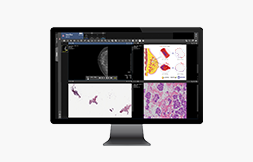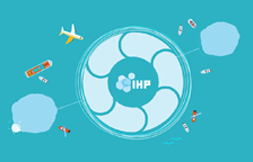Before we can actually start utilizing big data in healthcare, we need to first integrate all the data we have in storage. In this article, we’ll take a close look into why integrating the data is so important and what benefits can be gained from the integration.

Medical big data integration means the collection of all medical data scattered across different departments. Here, scattered data includes various types of data such as clinical information, medical images, ECG, body temperatures, blood pressures, genomic information, use cases, whitepapers, clinical trial data, and etc.

Integrating medical big data provides a comprehensive view of a patient’s health status.
The computing power of artificial intelligence (machine-learning) algorithms enables high-speed analysis of big data which, when applied to healthcare, enables medical professionals to treat each patient with a more holistic perspective*. The concept of population health also has similar roots. It is an approach to health that analyzes various types of data from a specific group of people in efforts to anticipate and manage their health conditions.
Furthermore, integrating medical big data enables treatment tailored to individual patients.
Until now, if you have a specific symptom, you would go to the hospital for examination and most likely be prescribed the standard (one-size-fits-all)** treatment and medication. But it’s possible that patients A and B with exactly the same symptoms could react differently to the same treatment/medication. One of them could even experience side effects.
Precision medicine***, undoubtedly one of the hottest keywords in medical industry at the moment, addresses this issue by optimizing diagnosis and treatments based on an individual’s comprehensive health data including genetic, environmental and lifestyle information.
In order to implement precision medicine, however, it is necessary to first ‘integrate the medical big data’ at hand, which in itself is not an easy task. In fact, integrating all the data generated from a single medical facility is difficult enough.
*Jung Young-hoon, , Korea Consumer Agency, 2017. 31
**NIH, https://ghr.nlm.nih.gov/primer/precisionmedicine/definition
***Moon Se-young et al, , Korea Institute of S&T Evaluation and Planning, 2016. 9

Basically, medical data generated within a hospital is distributed across different departments. What’s more, medical modality and information system vendors all use different formats for storing and communicating data, making it extremely difficult to store and manage different types of data as a whole.

You need a ‘medical big data platform’ to store, manage and utilize the dispersed data in an integrated manner.
For example, you can compare a big data platform to a train station or an airport—places where a lot of people gather to meet up and interact, and where vending machines, restaurants, and shops emerge as a result. The idea of a platform is basically to create an ecosystem in which different players interact with each other to produce new values and benefits. The same applies to medical big data as well. A platform is needed to collect and integrate the data scattered across different departments and different medical devices and information systems, and to produce new values as a result.
In this sense, INFINITT Healthcare Platform (IHP) is just the right medical big data platform for you.

INFINITT Healthcare Platform (IHP) is a vendor neutral archive for integrating all data generated within a medical facility. Here, a vendor neutral archive refers to a medical information solution that receives, stores, manages and opens up (for viewing) all medical data in standardized format, regardless of what vendor modalities and systems are used.
IHP brings together medical data from different departments under one platform where all data is comprehensively managed from creation to storage and usage. So what are the benefits of using IHP?

First, you can provide patient-centric care and treatment based on the data integrated under IHP. This is because integrated data gives you a more holistic perspective on a patient’s health status. You get to see both the small and the big picture.
Second, the data integrated under IHP can be shared and utilized not only within the medical facility but also with other medical facilities for collaboration and research purposes.
Third, the data integrated under IHP can also be used for artificial intelligence (AI), precision medicine and population health applications.
Medical big data and its integration is clearly gaining momentum globally. In the UK, the Healthcare Big Data Consolidation Center** is established to promote the sharing and utilization of medical data, and the United States is also pursuing a data construction project*** that links approximately 1 million people with genetic information and health information.
__
We will continue the discussion on potential applications of medical big data in the next article of the series.
-
Product Essay
INFINITT Enterprise Search: Streamlining radiologists’ search for the right data
#INFINITT_Enterprise_Search #radiology #data_use

-
Product Essay
A systematic, data-driven approach to dose management
#INFINITT_DoseM #dose_management

-
Product Essay
Data assetization: unlocking the true value of medical data
#data_assetization #enterprise_imaging #INFINITT_Healthcare_Platform

-
Product Essay
INFINITT PACS 7.0, redefining PACS for the evolving role of radiologists
#INFINITT_PACS #AI #collaboration #reading_productivity

-
Product Essay
How INFINITT MDT streamlines workflow for your multidisciplinary teams
#multidisciplinary_care #INFINITT_MDT

-
Product Essay
Enterprise imaging: all-in-one imaging strategy for healthcare enterprises
#enterprise_imaging #data_integration #data_sharing #multidisciplinary_care #big_data #AI

-
Product Essay
Time to digitalize your pathology workflow
#digital_pathology #INFINITT_DPS

-
Product Essay
Managing radiation dose with INFINITT DoseM
#dose_monitoring_solution #DRL #cumulative_dose #protocol_management

-
Industry Insight
Dose management policies in the U.S., Europe and Japan
#radiation_dose #patient_safety #regulatory_policies #reimbursements

-
Product Essay
Why you need a digital pathology solution
#digital_pathology #INFINITT_DPS

-
Industry Insight
A beginner's guide to pathology
#pathology_workflow #digitalization_of_pathology #challenges

-
Product Essay
The medical big data platform—INFINITT Healthcare Platform (IHP)
#medical_big_data #VNA #enterprise_imaging_platform

-
Industry Insight
The three big questions about medical big data
#medical_big_data #what_is_it? #how_big? #how_diverse?





